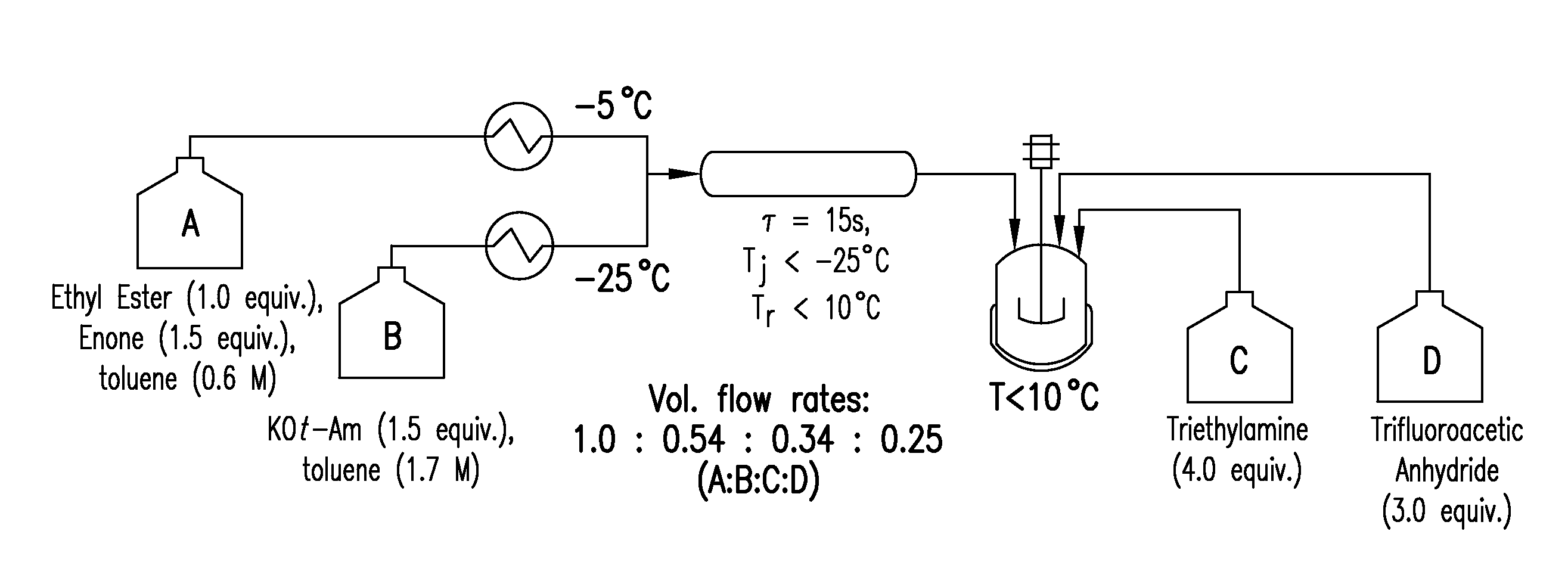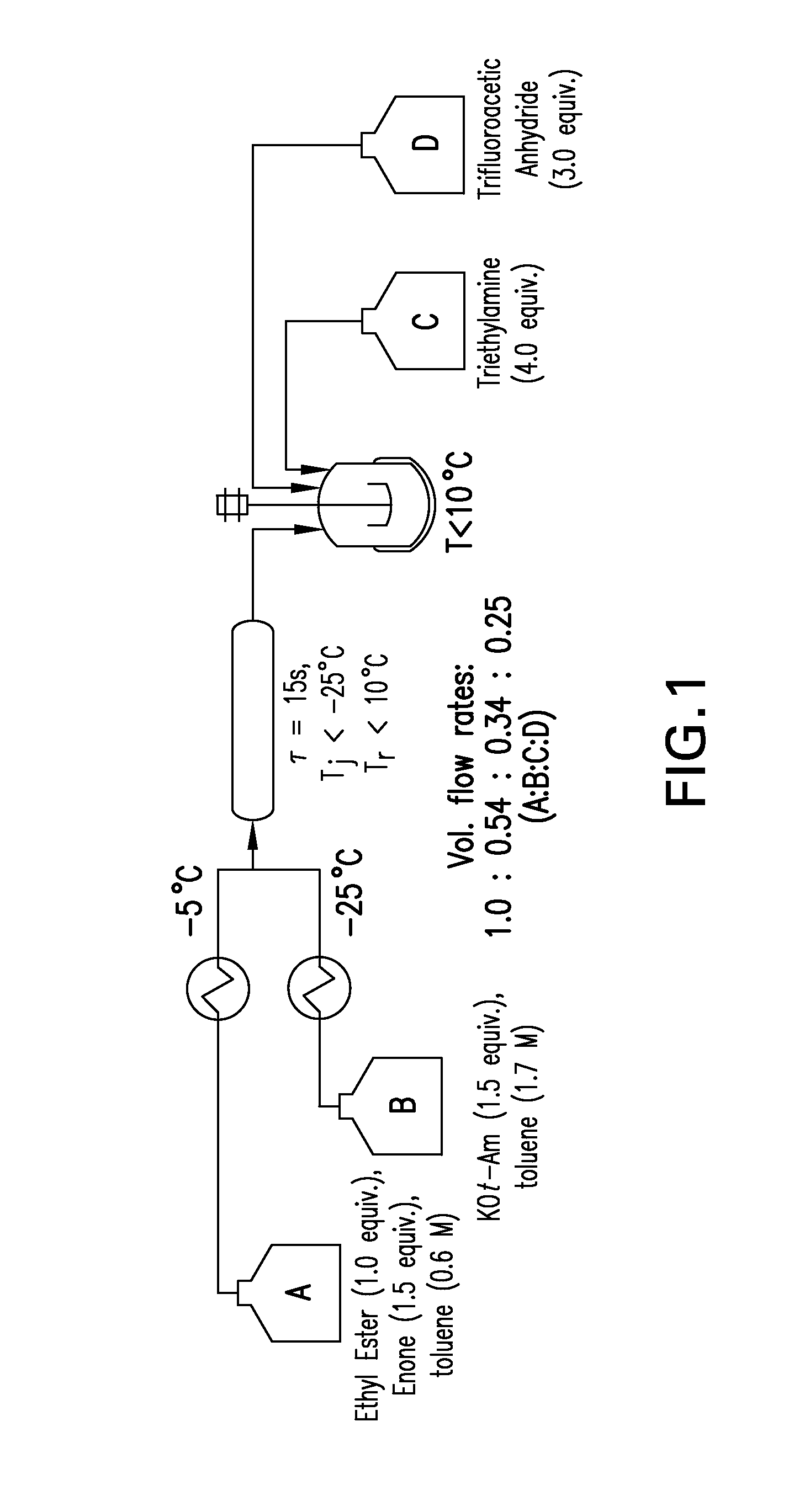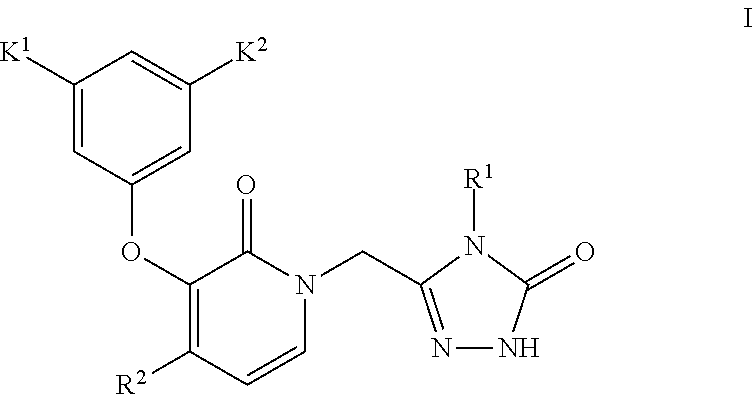Process for making reverse transcriptase inhibitors
a reverse transcriptase inhibitor and reverse transcriptase technology, applied in the field of reverse transcriptase inhibitors, can solve the problems of high susceptibility to debilitating and ultimately fatal opportunistic infections
- Summary
- Abstract
- Description
- Claims
- Application Information
AI Technical Summary
Benefits of technology
Problems solved by technology
Method used
Image
Examples
example 1
[0088]
Step 1
[0089]
Phenyl Methylcarbamate
[0090]40% Aqueous methylamine (500 g, 6.44 mol) was charged to a 2 L vessel equipped with heat / cool jacket, overhead stirrer, temperature probe and nitrogen inlet. The solution was cooled to −5° C. Phenyl chloroformate (500.0 g, 3.16 mol) was added over 2.5 h maintaining the reaction temperature between −5 and 0° C. On complete addition the white slurry was stirred for 1 h at ˜0° C.
[0091]The slurry was filtered, washed with water (500 mL) and dried under a nitrogen sweep overnight to afford 465 g (96% yield) of the desired product as a white crystalline solid; 1H NMR (CDCl3, 500 MHz): δ 7.35 (t, J=8.0 Hz, 2H), 7.19 (t, J=8.0 Hz, 1H), 7.12 (d, J=8.0 Hz, 2H), 4.95 (br s, 1H), 2.90 (d, J=5 Hz, 3H).
Step 2
[0092]
2-(2-Hydroxyacetyl)-N-methylhydrazinecarboxamide
[0093]Part A: Phenyl methylcarbamate (300 g, 1.95 mol) was charged to a 2 L vessel with cooling jacket, overhead stirrer, temperature probe, reflux condenser and nitrogen inlet. IPA (390 mL) wa...
example 2
[0100]
Step 1—Ethyl Ester Synthesis
Experimental Procedure
[0101]
Ethyl 2-(3-chloro-5-cyanophenoxy)acetate (A)
[0102]A 1 L round bottom flask equipped with overhead stirring was charged with 3-chloro-5-hydroxybenzonitrile (50.0 g, 98 wt % purity, 319 mmol) and 15% aqueous DMF (200 mL DMF+35.5 mL H2O). To the resulting solution was added diisopropylethylamine (61.3 mL, 99.0% purity, 1.1 equiv) and ethyl 2-bromoacetate (35.7 g, 98% purity, 1.15 equiv) at ambient temperature. The resulting solution was warmed to 50° C. under nitrogen and aged for 12 h. Upon completion of the reaction the batch was cooled to 0-5° C. To the clear to slightly cloudy solution was added 5% seed (3.8 g, 16.0 mmol). H2O (64.5 mL) was added to the thin suspension via syringe pump over 3 h while maintaining the temperature at 0-5° C. Additional H2O (200 mL) was added over 1 h while maintaining the temp at 0-5° C. The final DMF / H2O ratio is 1:1.5. The resulting slurry was aged 1 h at 0-5° C. The batch was filtered an...
example 3
Ethyl 2-(3-chloro-5-cyanophenoxy)acetate (A)
[0116]
[0117]Three step one pot sequence
Steps 1 and 2
[0118]To an oven dried 250 mL round bottom flask was added sodium 2-methylpropan-2-olate (12.85 g, 134 mmol) and BHT (0.641 g, 2.91 mmol) then added DMF (30 mL). After 10 min, a light yellow solution resulted. 2-Phenylethanol (7.66 ml, 63.9 mmol) was added and the solution exothermed to 35° C. The light yellow solution was warmed to 55° C. and then a solution of 3,5-dichlorobenzonitrile (10 g, 58.1 mmol) in DMF (15 mL) was added over 2 h via syringe pump. The resulting red-orange suspension was aged at 55-60° C. After 2 h, HPLC showed >98% conversion to the sodium phenolate.
Step 3
[0119]The suspension was cooled to 10° C., then ethyl 2-bromoacetate (8.70 ml, 78 mmol) was added over 1 h while maintaining the temperature 99% conversion to the title compound.
Work-Up and Isolation:
[0120]To the suspension was added MTBE (50 mL) and H2O (50 mL) and the layers were separated. The organic layer wa...
PUM
| Property | Measurement | Unit |
|---|---|---|
| temperature | aaaaa | aaaaa |
| temperature | aaaaa | aaaaa |
| temperature | aaaaa | aaaaa |
Abstract
Description
Claims
Application Information
 Login to View More
Login to View More - R&D
- Intellectual Property
- Life Sciences
- Materials
- Tech Scout
- Unparalleled Data Quality
- Higher Quality Content
- 60% Fewer Hallucinations
Browse by: Latest US Patents, China's latest patents, Technical Efficacy Thesaurus, Application Domain, Technology Topic, Popular Technical Reports.
© 2025 PatSnap. All rights reserved.Legal|Privacy policy|Modern Slavery Act Transparency Statement|Sitemap|About US| Contact US: help@patsnap.com



